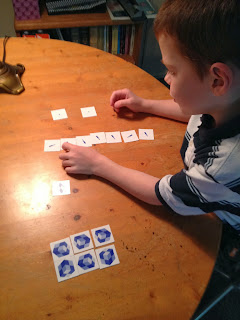Teaching math to John is getting so interesting--and I am a real fan of RightStart Math!
I don't know anything about what is typically taught in first grade math. I just know that we're in Level B, which is intended for first grade, and we're about six weeks in at our pace of two to three lessons per week. I think John (6-3/4) enjoys math so far and is keeping up with it, but I have no reason to think he's got any kind of 'extra smarts' for it. What I think is that the RightStart method is totally great.
I took photos documenting our three lessons this week.
The lessons have been emphasizing the numerical place values for quite a long time. Recently, we began using the "base ten cards," a manipulative which visually shows ones, tens, hundreds, and thousands.
Then John learned about "trading." I gave him a huge "mess" of base ten cards and asked him how on earth he might calculate the full value represented. I am a fan of using the Socratic method of teaching whenever I can, and it is a method that meshes beautifully with RightStart Math, which encourages the child to figure out the concept himself (before later having to memorize math facts).
 |
| John pondering how he could calculate the value represented by the mess of base ten cards. His first idea, "I should organize them!" |
 |
| John organized the base ten cards into groups. |
I then explained to John that he could trade in some of his base ten cards for high value cards so there would be fewer cards to count. "What do you think you could trade in?" "I could trade in ten tens for one hundred!"
 |
| After trading in various base ten cards, John had reduced his number of cards to count. |
Once John had reduced his base ten cards as far as possible, he selected the matching place value cards, e.g., six "thousand" base ten cards = the 6,000 place value card.
 |
| The appropriate place value cards with the base ten cards |
Layering the place value cards reveals the answer of what the whole mess of base ten cards was worth!
 |
| Final answer: the mess of base ten cards was valued at 6,172. |
I wrote down three four-digit numbers on slips of paper and asked John to use our place value cards to re-create the numbers. (This makes sure he understands, for example, that the '1' in 1849 represents 1,000.)
 |
| Converting my handwritten numbers into place value cards |
John piped up quickly, showing a good understanding of place value: "Well, I know the answer will be at least 6,000 because 1,000 plus 2,000 plus 3,000 is 6,000. But after that I don't know what to do." I told him that was a great estimate and a way of estimating that even adults use.
I reminded him quietly that he might find it helpful to use the base ten cards. He excitedly grabbed enough to represent each of the four-digit numbers.
Then he organized his various base ten cards: all thousands together, all hundreds together, all tens together, all ones together.
Then John traded his base ten cards until he had as few cards as possible.
And John figured out how many sheep were in all three flocks:
1849 + 2735 + 3817 = 8401
He was really tickled and so was Mama!
I know RightStart is a really parent-intensive math method based on Montessori principles: One lesson might take John and me 45 minutes, which is way longer than just handing him a workbook page to work through by himself. I know full well that my growing family duties might not allow me to continue with RightStart forever, but I sure can hope. Because of how much I hated math as a child, I am highly satisfied seeing John and Mary (who is doing RightStart Level A) both understanding math concepts--really getting them!--and liking the subject very much.
(I found this thorough review of RightStart, which might be interesting to some home teachers.)






I was amazed when we went through RS B the first time last year (in six months!). I thought the concepts were presented brilliantly. I'm inclined to think it's the crown jewel of the Rightstart program, though. We are moving through C, and again, it's not presenting much of a challenge for my mathy kids, but it's a weaker level overall. We are having to pair it with another program to actually continue to move forward.
ReplyDeleteCourtney: Good to get a peek ahead. At our pace of 2-3 lessons per week, we'll definitely need the whole long year to finish Level B. I'll be interested to see the program ahead.
ReplyDelete